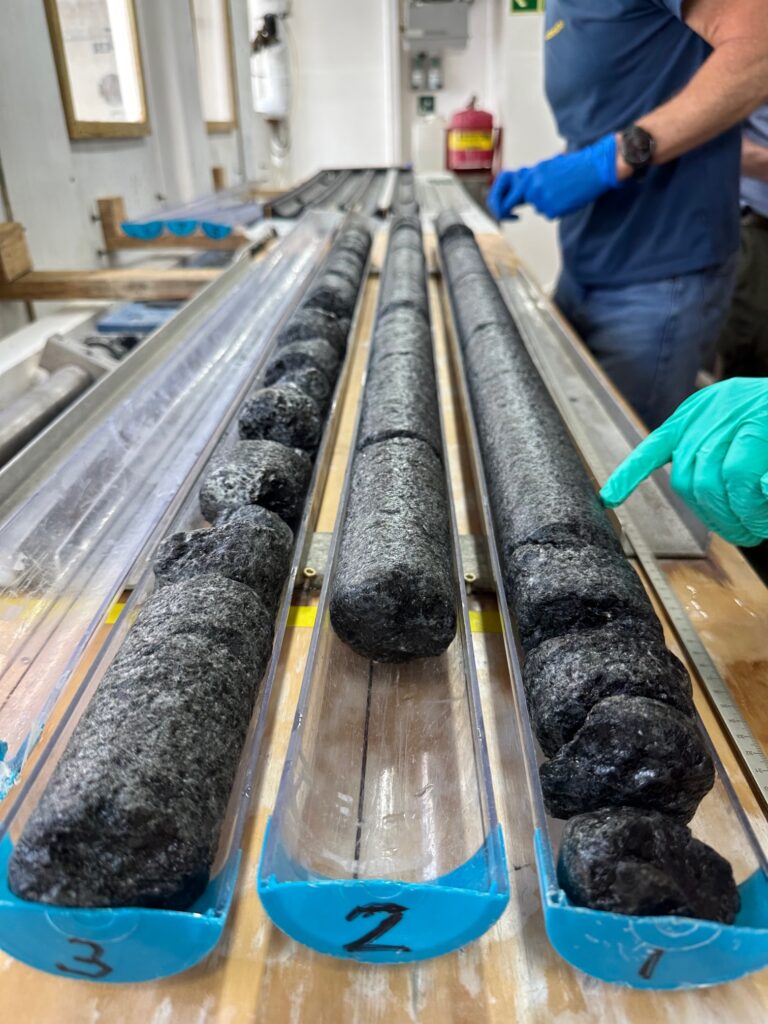
Preliminary Findings for Expedition 399
After the news that the JOIDES Resolution will no longer be supporting scientific drilling with the International Ocean Discovery Program, Expedition 399 had a new goal: legacy. The scientists onboard are not just thinking about this expedition, but are bringing back unique cores for future generations to study. “It’s like bringing rocks back from the moon, we need to be thoughtful with what we do with them,” said Frieder Klein, a marine petrologist from Woods Hole Oceanographic Institution. It is unclear whether the United States has a plan for a future drilling vessel. Given this uncertainty, it is important for the scientific ocean drilling community to think about every decision made on each expedition and how this could impact the data available for the next generation of scientists to explore.
While the science party expected to access mantle rock in U1601C relatively easily because of its location on the mid Atlantic ridge, they had no idea how easy or difficult it would be to access deep mantle rocks in this area. Typical hard rock expeditions in similar rock formations yield cores approximately every 3 hours and are usually less than 50% recovery. This expedition was unusual – cores were coming up on deck once per hour and recovery was over 100% on many occasions. The drill was cutting through the serpentinized mantle rocks like butter and the team reached a final depth of 1267.8 mbsf (meters below sea floor) after about a month of drilling. “This is the dream site for oceanic geologists,” explained Margot Godard, a geochemist from the University of Montpellier.
Preliminary results suggest that the deeper we drilled into the hole, the “fresher” the mantle rocks were that we accessed – meaning the rocks are less altered by sea water interactions. In the freshest rocks, we’re seeing less altered rocks with lower serpentinization which is very exciting for geologists who want to understand what happens before these rocks are brought to the surface.
Logging the hole helped to contextualize the rock pieces brought up from the sea floor to fit into the larger picture of the hole. “We need to ground truth the data,” said Kristin Dickerson, a PhD candidate from the University of California, Santa Cruz. The physical properties specialists on Expedition 399 were especially curious about the directionality of some of the rock samples that can be measured by the logging tools. “Each rock is like a page from a book,” explained Frieder. Logging can describe the missing pages of the book.
On the microbiology side, there is even more excitement. Carbonate found in the rocks likely indicates zones where there was fluid flow and is therefore more favorable for hosting life. The microbiologists and geochemists are beginning to look at the relationship between carbonate and hydrogen production as this may provide insight about what the conditions were like for early life on earth – and also what the conditions could potentially be like on the surface of icy moons such as Enceladus.
Hello Lesley,
I was sorry to read Expedition 399 has been stopped. It has been really succesful with high core recoveries (by the way, recovery cannot be over 100%…). Hoping the funding will still allow scientists to fully complete their expertise at the labs.
Journey To The Center of The Earth by Jules Verne was one of my favorite books when I was learning to read about scientific subjects as a teenager!
I later studied geology in college and could only imagine what it would be like to do drilling like this for real!
So many questions to answer…
This might be a good start…